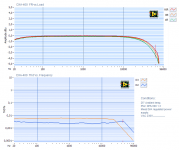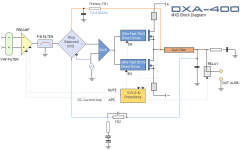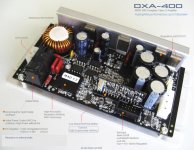Hi AP2,
thank you for posting the information... I want to build a class D hifi amp for my home listening and am looking for class D amp modules providing best possible sound quality while output power is not so important. I looked at the DXA-400 module, as well as some other modules (DPA-600, MXD-500, etc.) at www.audiopower.it and they all seem to have impressive specs but I do not know which one would be best suitable for my purpose (best sound quality - maybe not best measurements but most enjoyable listening - although I know it may be quite subjective)...
Please advice which of them would be best for me. And suitable PSU, please.
Thank you
thank you for posting the information... I want to build a class D hifi amp for my home listening and am looking for class D amp modules providing best possible sound quality while output power is not so important. I looked at the DXA-400 module, as well as some other modules (DPA-600, MXD-500, etc.) at www.audiopower.it and they all seem to have impressive specs but I do not know which one would be best suitable for my purpose (best sound quality - maybe not best measurements but most enjoyable listening - although I know it may be quite subjective)...
Please advice which of them would be best for me. And suitable PSU, please.
Thank you
Hi,
To TCX
yes I'm agree with you, certain measures can direct the choice, but then ensure that the amplifier has a great sound.
I can tell you that in these new amplifiers was cured audio timbre. (Eg frequency response contains fitting works) are not visible from the curve.
flat response is only good for demonstrating the qualities of the amplifier, after this, Is Necessary fitting works as commercial esoteric amp,(flat 10Hz to..) is not good for the home audiophile listening.
The central work of AudioPower is not private (certainly important) But companies that need high quality, innovation at competitive prices.
I put these few steps to the right information, it is now possible to replace the heavy toroid with advanced technology and performance far superior to the traditional toroidal PSU (see thd vs. Freq.) Flat segment on 20-100Hz. this is not possible with other current SMPS. then this is information. (Or revolution)🙂
you can turn to support-audiopower, I'm sure that will advise you well, you can say that speakers have to match the amp.
all amplifiers have true high-resolution on high-audio band and innovative circuit of protection.
Regards
To TCX
yes I'm agree with you, certain measures can direct the choice, but then ensure that the amplifier has a great sound.
I can tell you that in these new amplifiers was cured audio timbre. (Eg frequency response contains fitting works) are not visible from the curve.
flat response is only good for demonstrating the qualities of the amplifier, after this, Is Necessary fitting works as commercial esoteric amp,(flat 10Hz to..) is not good for the home audiophile listening.
The central work of AudioPower is not private (certainly important) But companies that need high quality, innovation at competitive prices.
I put these few steps to the right information, it is now possible to replace the heavy toroid with advanced technology and performance far superior to the traditional toroidal PSU (see thd vs. Freq.) Flat segment on 20-100Hz. this is not possible with other current SMPS. then this is information. (Or revolution)🙂
you can turn to support-audiopower, I'm sure that will advise you well, you can say that speakers have to match the amp.
all amplifiers have true high-resolution on high-audio band and innovative circuit of protection.
Regards
Last edited:
Hi AP2,
thank you for your response.
Does it mean that 2 DXA-400 modules and 1 DPS-500 PSU would best match my need? Or is there any superior combination? My speakers are 8 ohm floorstanders and I do not want much volume but high sound quality, as I wrote above.
BTW, does DPS-500 provide all necessary voltages for 2 DXA-400 modules?
Or do you think that I would get better results if I combined DPS-500 with some decent class AB amp module?
Thanks
thank you for your response.
Does it mean that 2 DXA-400 modules and 1 DPS-500 PSU would best match my need? Or is there any superior combination? My speakers are 8 ohm floorstanders and I do not want much volume but high sound quality, as I wrote above.
BTW, does DPS-500 provide all necessary voltages for 2 DXA-400 modules?
Or do you think that I would get better results if I combined DPS-500 with some decent class AB amp module?
Thanks
Last edited:
Hi tcx,Hi AP2,
thank you for your response.
Does it mean that 2 DXA-400 modules and 1 DPS-500 PSU would best match my need? Or is there any superior combination? My speakers are 8 ohm floorstanders and I do not want much volume but high sound quality, as I wrote above.
BTW, does DPS-500 provide all necessary voltages for 2 DXA-400 modules?
Thanks
Technically a DPS-500-1.3 is perfect for two DXA-400 at 8R.
yes, I also listen to low power but hit the bass drum feel dry and crisp.
This is without doubt a pleasant emotion.🙂
Hi AP2
Is this your design?
Looks real good.
What are the 1 ohm resistor fuses for .... the +-15V PSU? (if these are 0,25W resistors, it will give 0,5A .. makes good sense 😉 ... thay looks a bit larger than 0805)
BR Baldin 🙂
Is this your design?
Looks real good.
What are the 1 ohm resistor fuses for .... the +-15V PSU? (if these are 0,25W resistors, it will give 0,5A .. makes good sense 😉 ... thay looks a bit larger than 0805)
BR Baldin 🙂
Hi AP2
Is this your design?
Looks real good.
What are the 1 ohm resistor fuses for .... the +-15V PSU? (if these are 0,25W resistors, it will give 0,5A .. makes good sense 😉 ... thay looks a bit larger than 0805)
BR Baldin 🙂
Hi,
Thanks for appreciation, the result is not only my work.
yes 1R intends to FUSE for 15V AUX_OUT. (Becouse dxa-400 contains the regulators on board)
For precision is 1206, is only precautional for aux-Vout
eheh no nothing escapes😀
Last edited:
Why did you opt for an output relay?
It should be possible to make a noise free turn-on/off (not that I have succeded yet 🙂 ), so it should only be for the further protection if everything fails .... but then again, a lot of newer large prof. amps lieves without it ......
Are you using micro processor for protection circuit?
BR Baldin 😉
It should be possible to make a noise free turn-on/off (not that I have succeded yet 🙂 ), so it should only be for the further protection if everything fails .... but then again, a lot of newer large prof. amps lieves without it ......
Are you using micro processor for protection circuit?
BR Baldin 😉
Why did you opt for an output relay?
It should be possible to make a noise free turn-on/off (not that I have succeded yet 🙂 ), so it should only be for the further protection if everything fails .... but then again, a lot of newer large prof. amps lieves without it ......
Are you using micro processor for protection circuit?
BR Baldin 😉
I have two reasons for relay (present in all models).
on / off noise is Already solved.
protections is complex and ultra-fast without relay. if for unforeseen reasons breaks a mosfet, I know how to burn everything and even the speaker is at risk (probable for esoteric use is high cost). second reason, not interested in saving money. these amplifiers are perfect and even if the test failure, the fault has remained confined to one area. I seen many circuits amplifiers destroyed by an output short circuit. Relay is for security or for voltage out guard.
there are many expensive devices on these amps, I think the customer should not add anything when buying an amp, here there are op-amp to be replaced or regulator.. blue light🙂
i think this is correct way...
Last edited:
Hi Baldin,
On you blog I see DSP board, this is you development? (good job)
if yes,then I have a special request for you on it.
regards
On you blog I see DSP board, this is you development? (good job)
if yes,then I have a special request for you on it.
regards
You can't claim it load independent based on that measurement. The THD vs Freq only displays D3 and D4 but doesn't define them, makes them meaningless. Is this the invented THD vs Supply ? Funny you'd opt to show that yet neglect already common class d measurement sets, like THD Vs Freq and Vs power at fixed frequencies. What of group delay, didn't that look good enough to show?
The "DC" feedback loop portrays a BIG cap to ground, notably BIG, because it's drawn as back to back anti series electrolytics. While those charge, you're going to tell me there's no DC thump? If so the relay is then optional.
I don't see how you've taken care of things like natural pitch when your control seems to suffer more than common alternatives like UCD that measure better based on the chosen few measurements you've provided, and at least do more to address things like natural pitch by not using the most absolute standard industrial parts possible, anymore.
Please show me again this innovation?
The "DC" feedback loop portrays a BIG cap to ground, notably BIG, because it's drawn as back to back anti series electrolytics. While those charge, you're going to tell me there's no DC thump? If so the relay is then optional.
I don't see how you've taken care of things like natural pitch when your control seems to suffer more than common alternatives like UCD that measure better based on the chosen few measurements you've provided, and at least do more to address things like natural pitch by not using the most absolute standard industrial parts possible, anymore.
Please show me again this innovation?
Hi Baldin,
On you blog I see DSP board, this is you development? (good job)
if yes,then I have a special request for you on it.
regards
Oh, no it's not. I just write that I think it is a very interesting board, and point to their homepage ....
AP2 you are boasting for audiophile esoteric amp with RELAYS inseries of LOAD😱😀
What about a graph for EMI and i cant see dedicated ground planes also.
Better if you also post Open load Vs freq Response Graph. This will tell how effectively the feedback dampens the inductor peaking at HF.🙂
Switching at 600khz for getting what?🙁
What about a graph for EMI and i cant see dedicated ground planes also.
Better if you also post Open load Vs freq Response Graph. This will tell how effectively the feedback dampens the inductor peaking at HF.🙂
Switching at 600khz for getting what?🙁
You can't claim it load independent based on that measurement. The THD vs Freq only displays D3 and D4 but doesn't define them, makes them meaningless. Is this the invented THD vs Supply ? Funny you'd opt to show that yet neglect already common class d measurement sets, like THD Vs Freq and Vs power at fixed frequencies. What of group delay, didn't that look good enough to show?
The "DC" feedback loop portrays a BIG cap to ground, notably BIG, because it's drawn as back to back anti series electrolytics. While those charge, you're going to tell me there's no DC thump? If so the relay is then optional.
I don't see how you've taken care of things like natural pitch when your control seems to suffer more than common alternatives like UCD that measure better based on the chosen few measurements you've provided, and at least do more to address things like natural pitch by not using the most absolute standard industrial parts possible, anymore.
Please show me again this innovation?
Hi,
Relay (especially for audio) is the end solution is greatly appreciated by many. amplifier has many innovative protection on board.it is very stable (without load or low load).
THD vs power which I invented?
I said that segment 20-100Hz is flat (with our SMPS). This is impossible with any other SMPS.
D2-D3 is a very significantly for this reason I presented. you did not know?
Did you see the linearity of thd vs frequency? Show me another amp with this linearity please.
for frequency response vs load, I prefer 1dB difference instead of perfectly superimposed becouse amplifier stability is very important.
I see no problem with the FB2, this amplifier is very different from all others and was designed exclusively for the better (not interested in doing a normal amp, market is full of amps).
digital engine is the fastest existing, 80 ns from input to gate mosfet with 30ns DT are not easy to manage.
Yes I like to invent (not Measure) but revolutionary power supply with performance exceeding traditional toroid with 2x22000uF.
P.S. THD vs. frequency at 30w(4R)
ok, you can link your loved udc with SMPS and put the THD vs. frequency
After talking about the differences, this is seriously compare.
regards
Last edited:
AP2 you are boasting for audiophile esoteric amp with RELAYS inseries of LOAD😱😀
What about a graph for EMI and i cant see dedicated ground planes also.
Better if you also post Open load Vs freq Response Graph. This will tell how effectively the feedback dampens the inductor peaking at HF.🙂
Switching at 600khz for getting what?🙁
Hi,
FB2 is direct connected at out pin,
this model of relay is present on Sony,Rotel,kenwood etc etc.
as ground plane are you talking about.
This PCB has four layers with advanced technology of alternating-gnd planes.
SN/R is 106 dB (remember however that the band is 60kHz)
and thanks to high speed of stage, to definition at high-audio-frequencies is comparable to a good class AB.
I have a question for you.
you know what is real sampled frequency on a CD player?🙂
Regards
Last edited:
Hi,
This project is very refined and very complete and innovative.
eg. mute automatically insert when switch on/off or entry-exit by protections (soft audio release).
DXA-400/600 have:
UVLO-guard on all voltage,
temperature protection,
output short circuit (even at max power).
DC-out guard (> 3Volt),
mute control,
APC active control of power (depending on the reactive load at audio envelope),This is based on a DC current loop in real time.
preamplifier to connect directly to a CD player,
result is, absolute purity of sound at maximum power (no thd Introduces at audio peak)
is not simply destroy it.🙂
Regards
This project is very refined and very complete and innovative.
eg. mute automatically insert when switch on/off or entry-exit by protections (soft audio release).
DXA-400/600 have:
UVLO-guard on all voltage,
temperature protection,
output short circuit (even at max power).
DC-out guard (> 3Volt),
mute control,
APC active control of power (depending on the reactive load at audio envelope),This is based on a DC current loop in real time.
preamplifier to connect directly to a CD player,
result is, absolute purity of sound at maximum power (no thd Introduces at audio peak)
is not simply destroy it.🙂
Regards
Last edited:
Hi,
FB2 is connected at out pin,
this (model)relay is present on Sony,Rotel,kenwood etc etc
as ground plane are you talking about.
This PCB has four layers with advanced technology of alternating-gnd planes.
SN/R is 106 dB (remember however that the band is 60kHz)
and thanks to high speed of stage, to definition at high-audio-frequencies is comparable to a good class AB.
I have a question for you.
you know what is real sampled frequency on a CD player?🙂
Regards
I have seen many post filter feedback amps who have peaking still present at HF at openloads, so your excuse being that you have 2 feedback loop enclosing the filter holds very little weigthage🙂
Having a 4 layer PCB with alternate GPs is nice idea, but i prefer a GP on the top most layer also as it reduces the emi drastically.😉
44.1khz of sampling frequency of CD player irks you so much?😀
Hi,I have seen many post filter feedback amps who have peaking still present at HF at openloads, so your excuse being that you have 2 feedback loop enclosing the filter holds very little weigthage🙂
Having a 4 layer PCB with alternate GPs is nice idea, but i prefer a GP on the top most layer also as it reduces the emi drastically.😉
44.1khz of sampling frequency of CD player irks you so much?😀
PCB strategy is very complex, with experience in designing special circuits you know well..only.
44.1Khz? now I understand why you think many 600kHz😀😀
Regards
- Status
- Not open for further replies.
- Home
- Amplifiers
- Class D
- New DXA-400 class D Amplifier-Info


